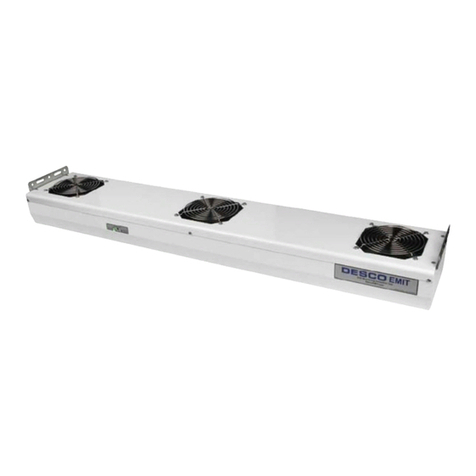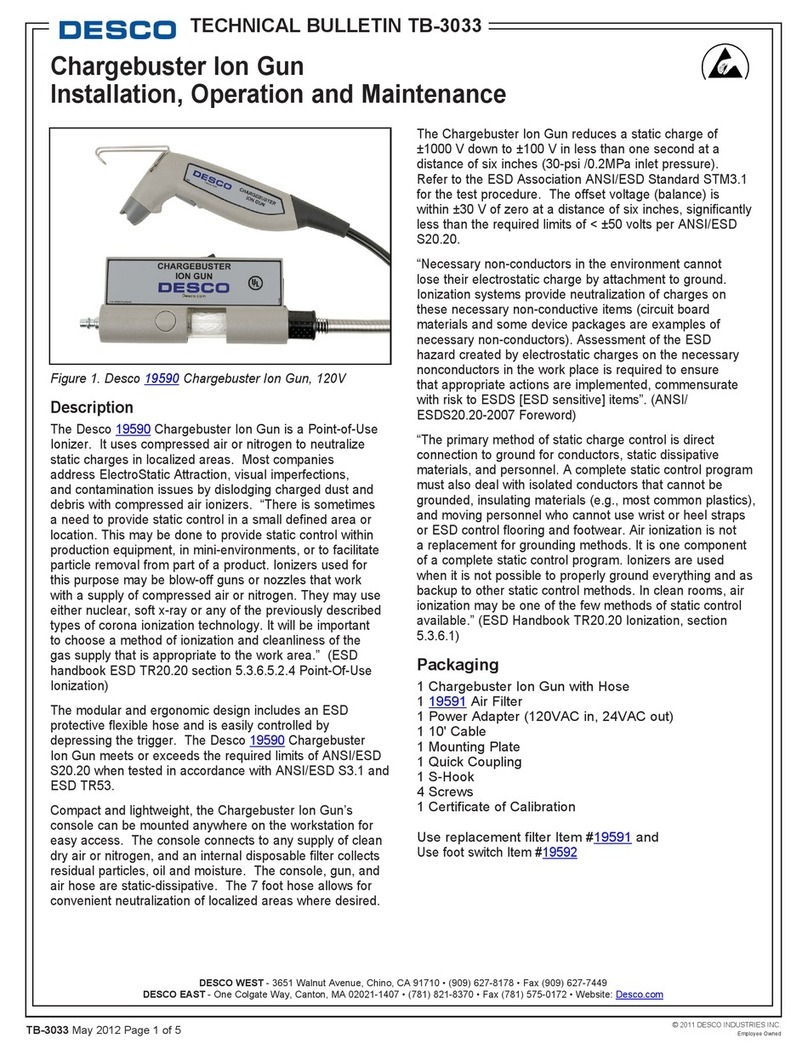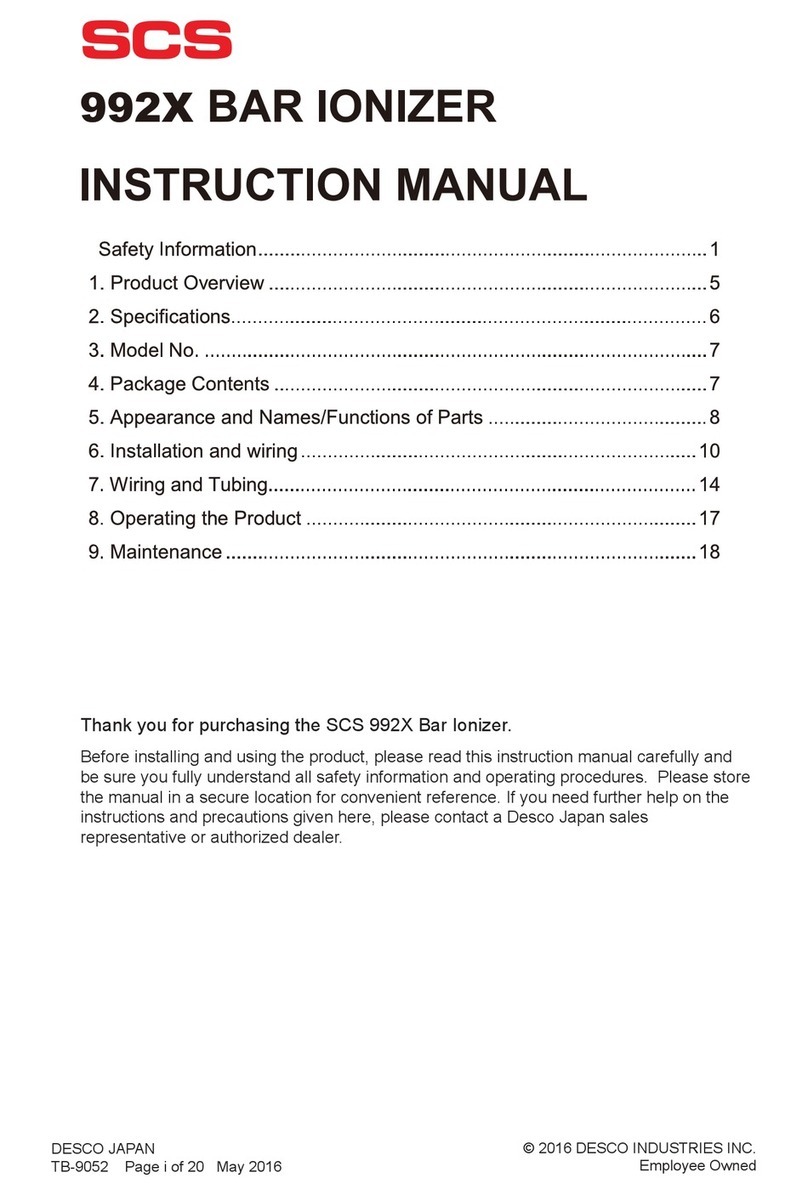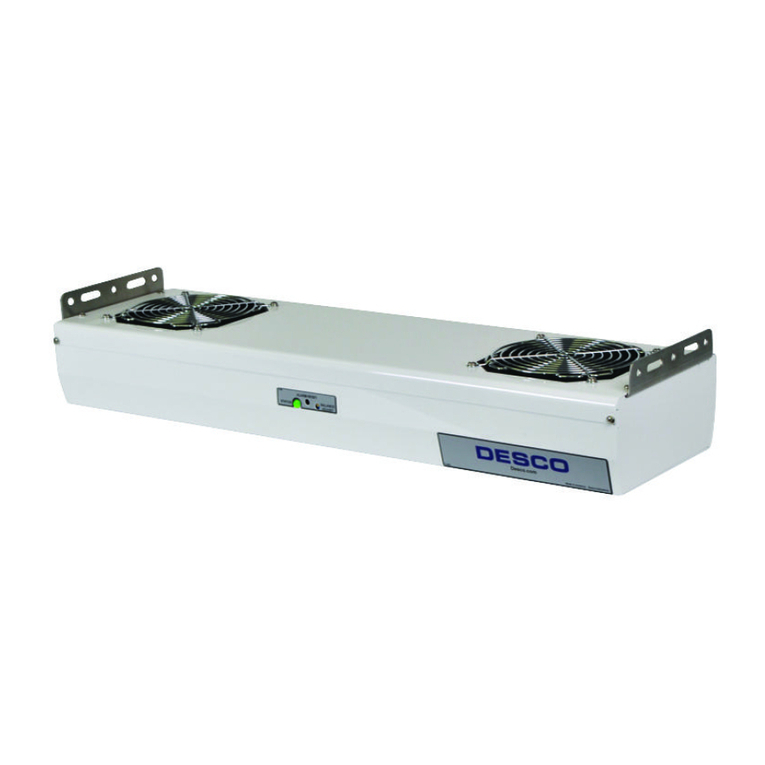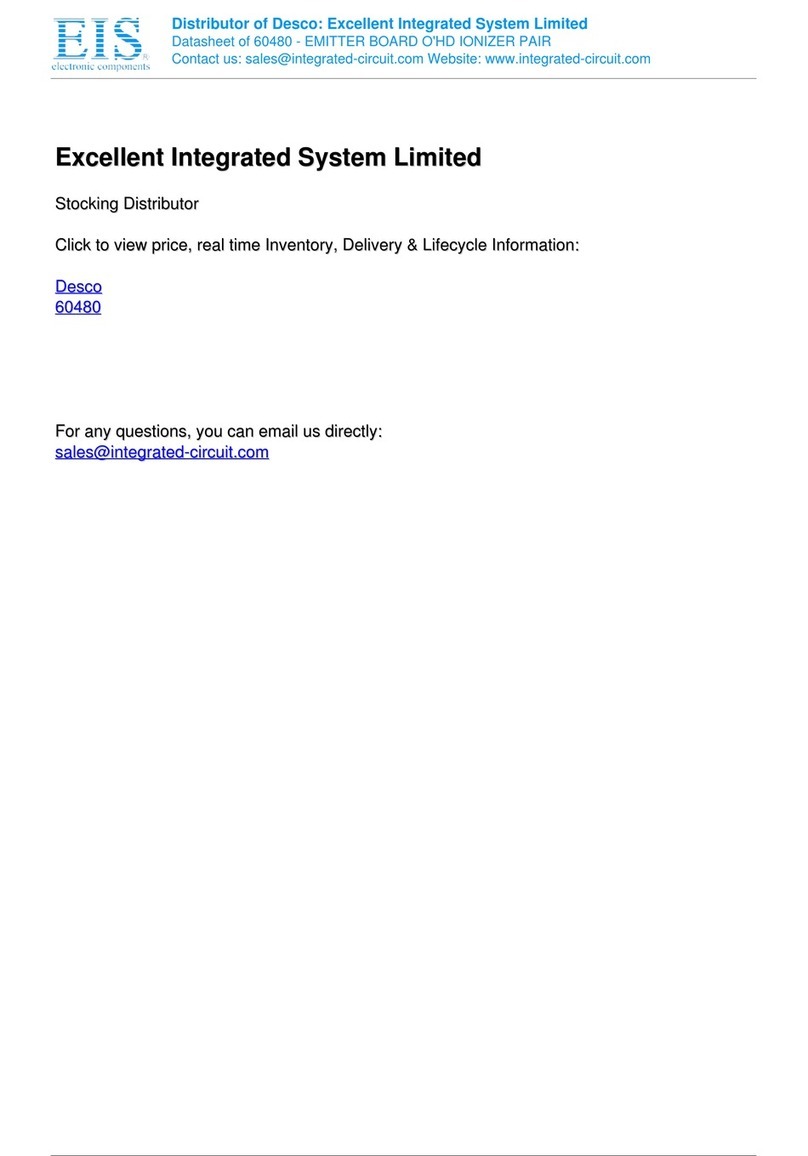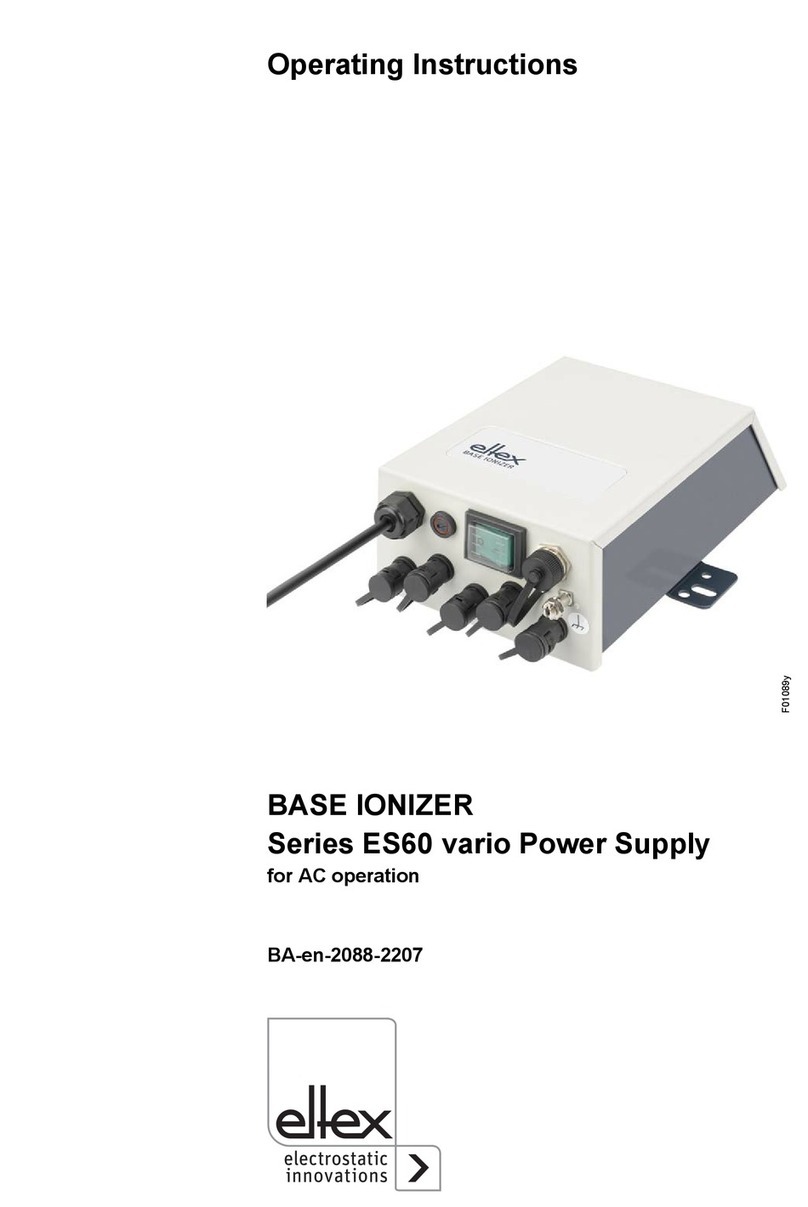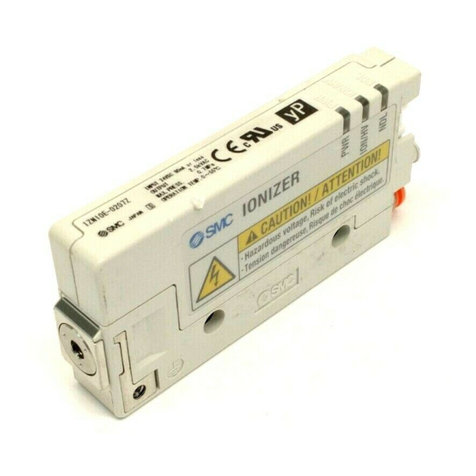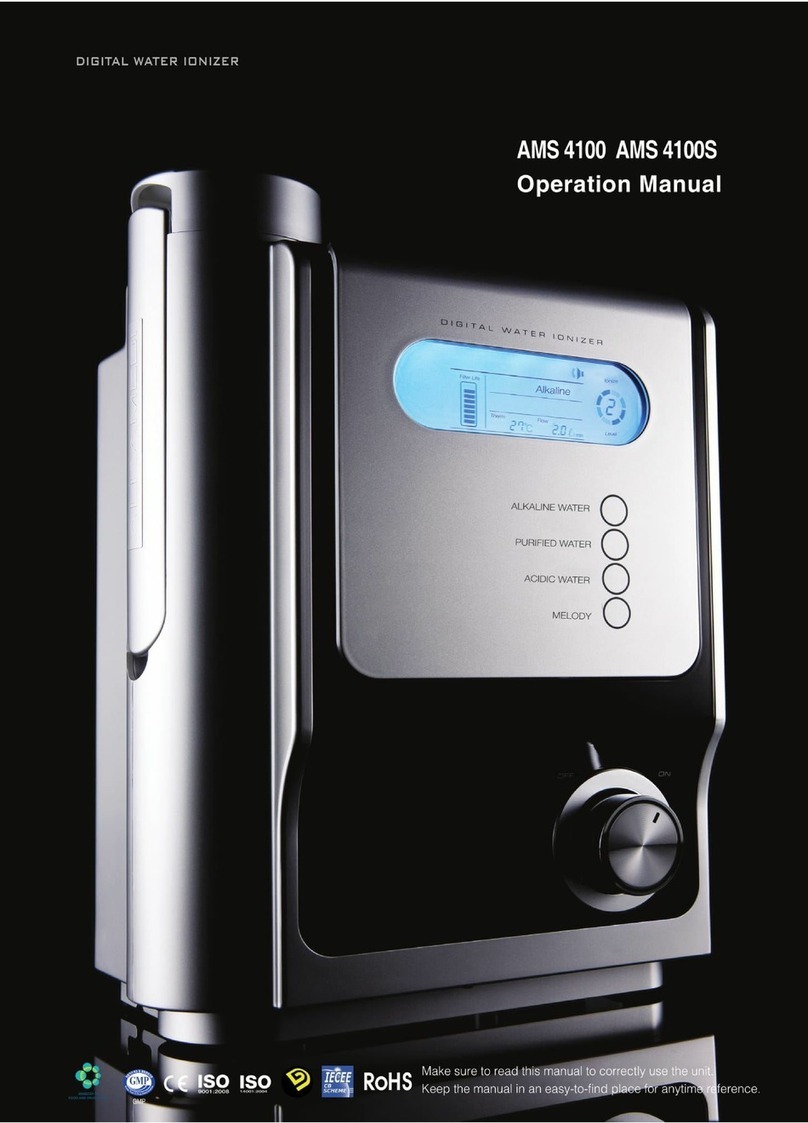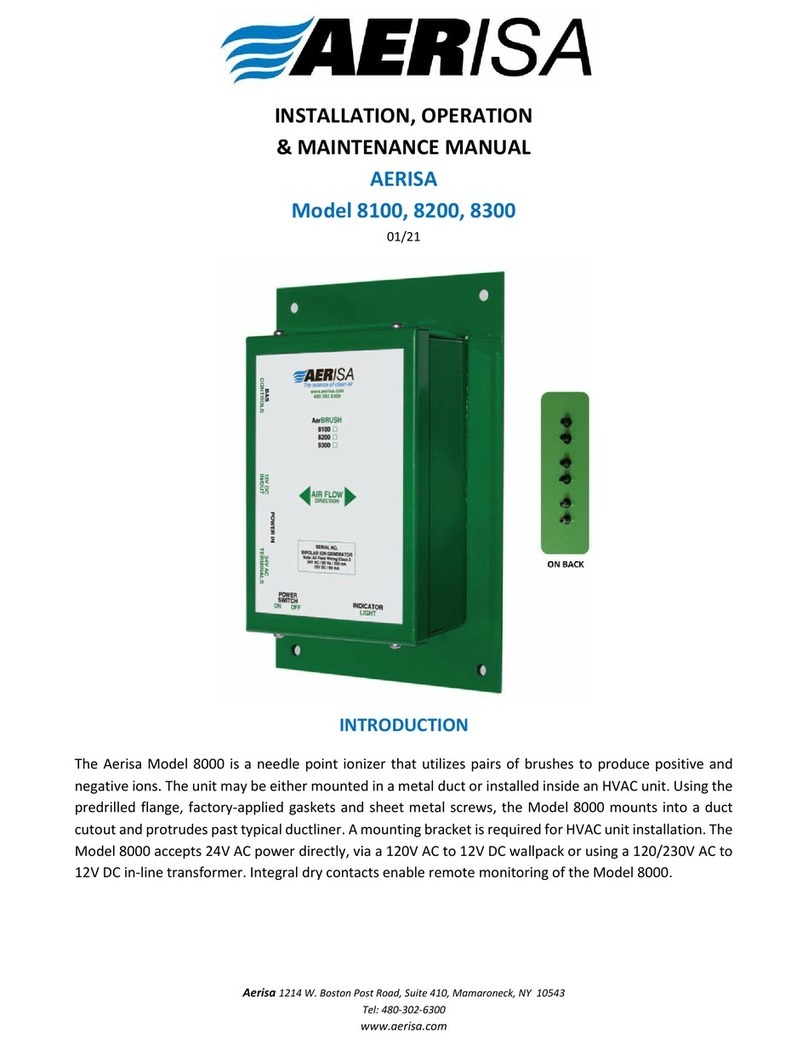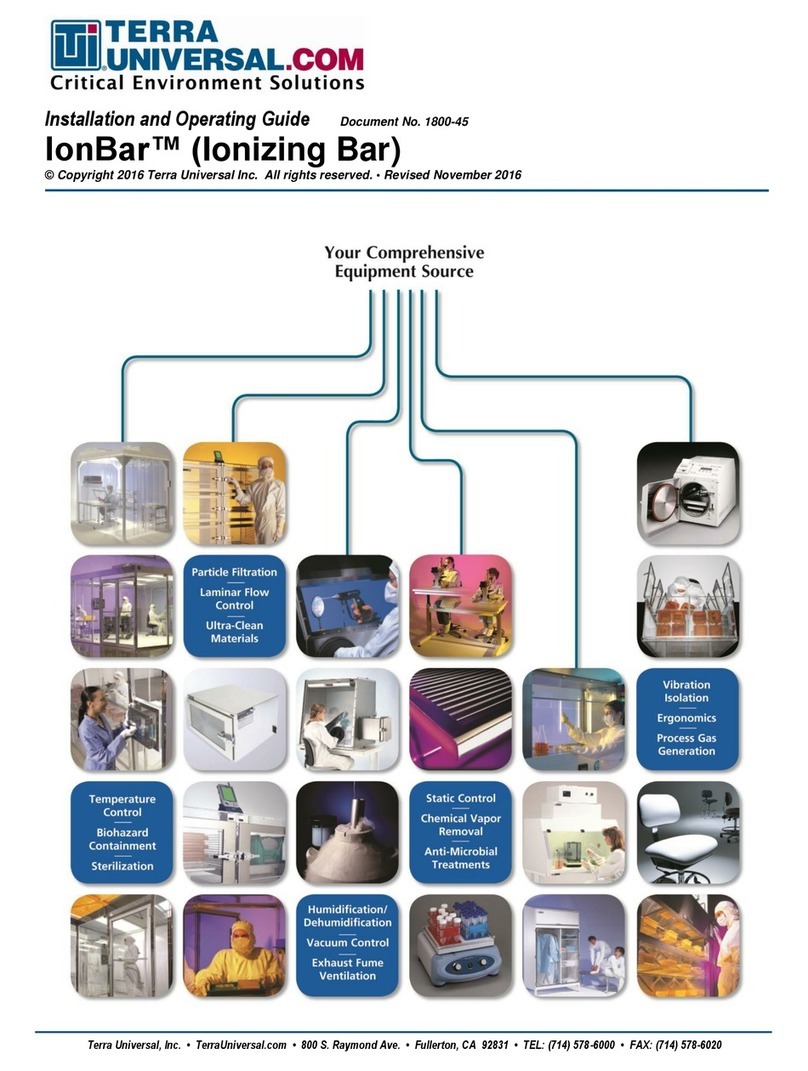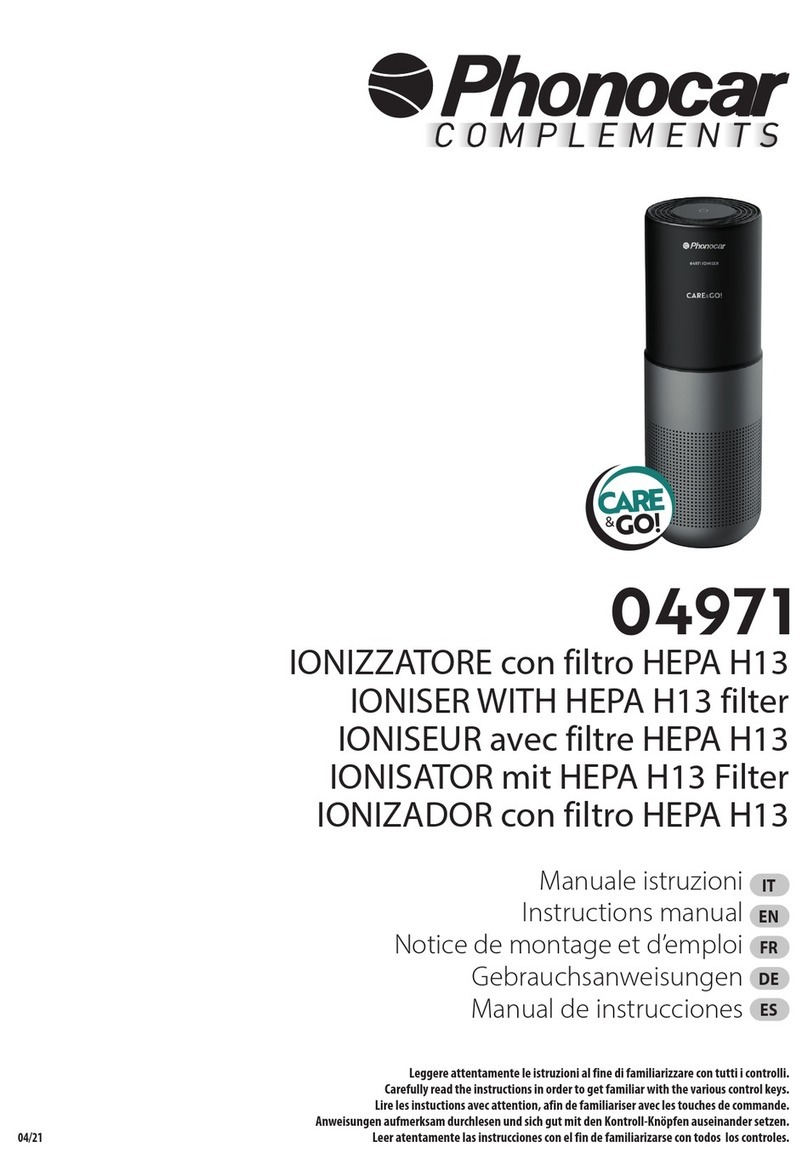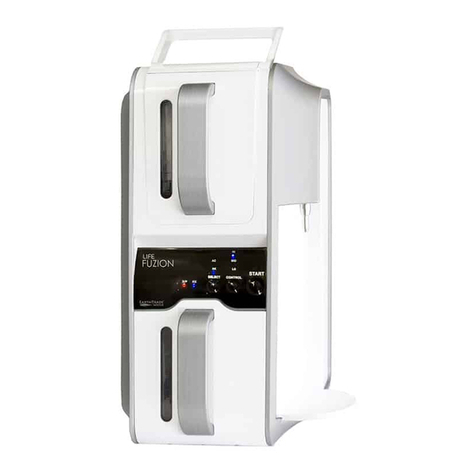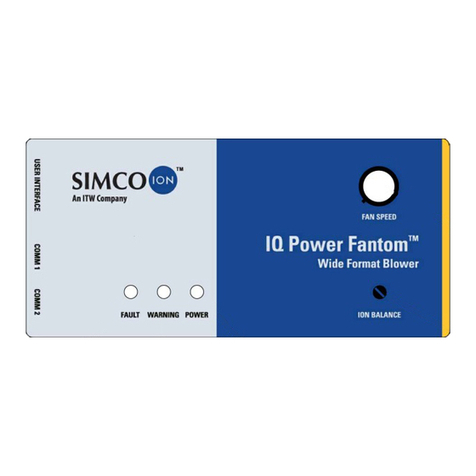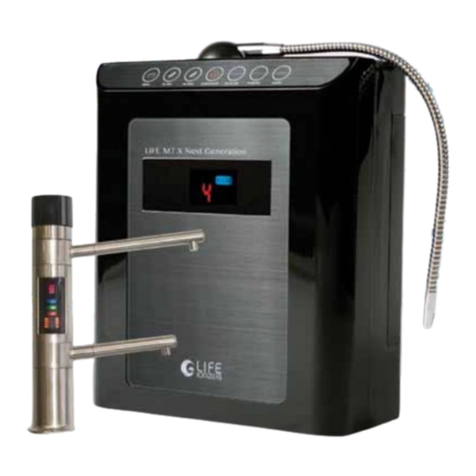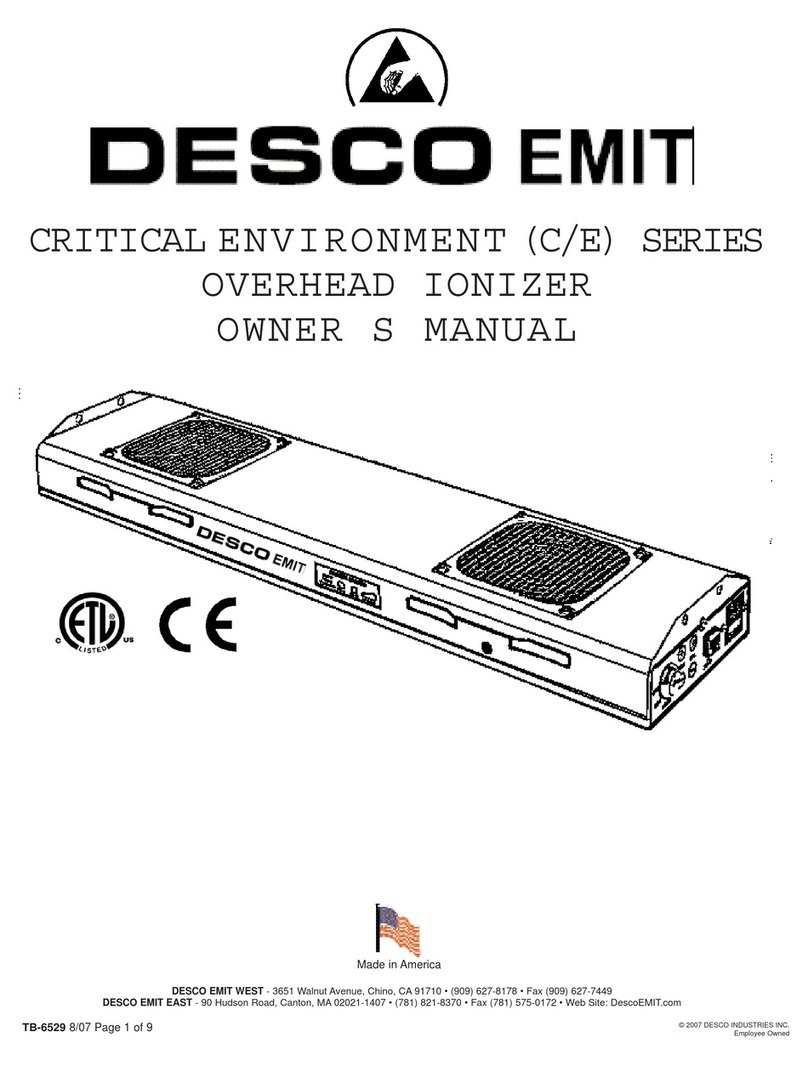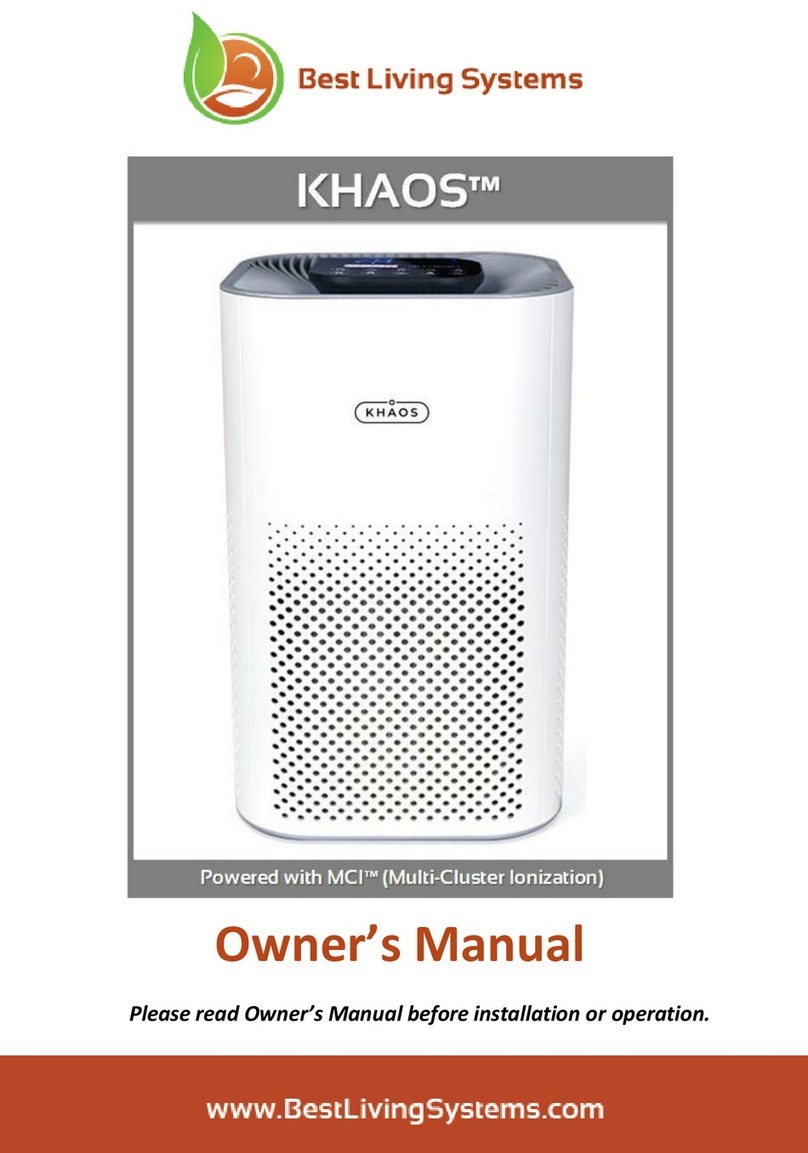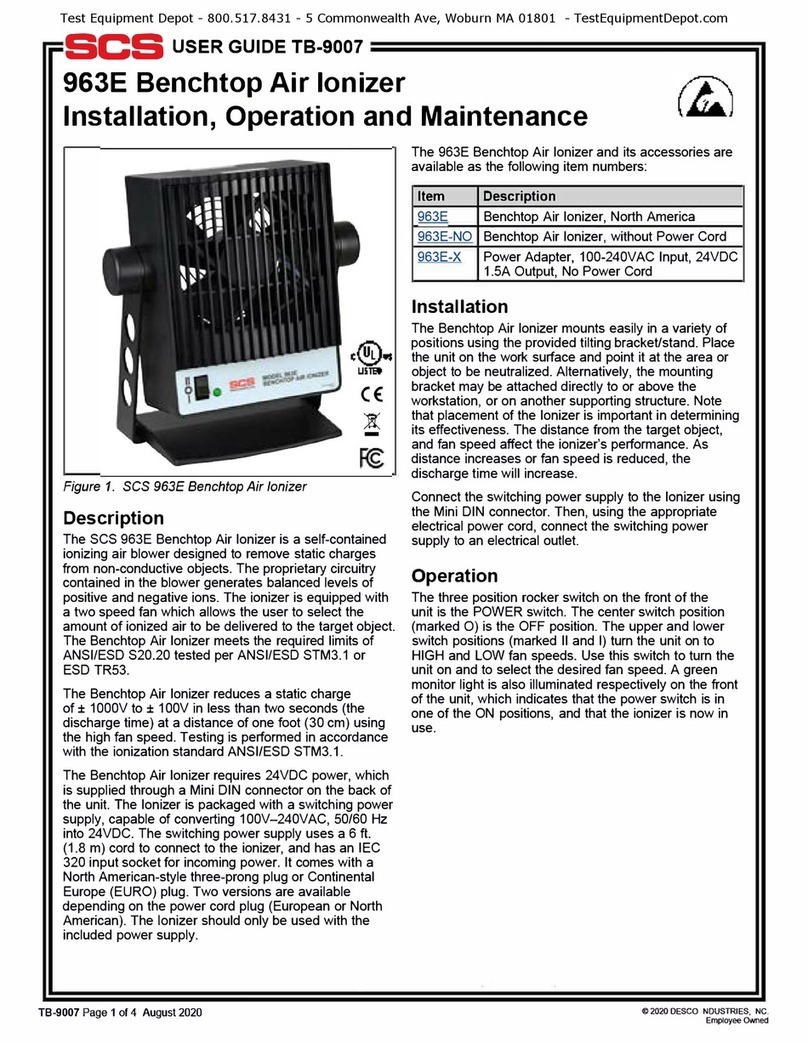
TB-2079 February 2010 Page 1 of 4
DESCO WEST - 3651 Walnut Avenue, Chino, CA 91710 • (909) 627-8178 • Fax (909) 627-7449
DESCO EAST - One Colgate Way, Canton, MA 02021-1407 • (781) 821-8370 • Fax (781) 575-0172 • Web Site: Desco.com
TECHNICAL BULLETIN TB-2079
Made in America
Figure 1. Ion Python Hand Gun (Controller with Hose)
Description
The Desco Ion Python Neutralizing Hand Gun is a ready-to-use
unit designed for use in applications and areas where static can
create manufacturing or handling problems. These units quickly
and effectively neutralize bulk static charges and aid in controlling
contamination by dislodging dust and debris attracted by static
electricity. Airflow may be easily adjusted from a gentle stream to
a powerful blast. These units are designed for use in applications
and areas where ElectroStatic Attraction contamination create
manufacturing or handling problems (Ref: ESD Handbook
TR 20.20 paragraph 5.3.6.5.2.4 Point of Use Ionization). The
Ion Python meets or exceeds the recommended technical
requirements of ANSI/ESD S20.20 tested in accordance with
ANSI/ESD S3.1.
Ionizers are useful in preventing electrostatic charge generation,
ElectroStatic Discharge, ElectroStatic Attraction, as well as
preventing equipment latch-up and safety related shock. ANSI/
ESD S20.20 Paragraph 6.2.3.1 Protected Areas Requirement
states: “Ionization or other charge mitigating techniques shall be
used at the workstation to neutralize electrostatic fields on all
process essential insulators if the electrostatic field is considered
a threat.” Ionization is used to neutralize charges on process
necessary insulators and isolated semiconductors. Some
examples of process necessary insulators are: the PC board
itself, plastic test stands, plastic housing where a PCB may
be mounted, as well as computer monitor screens and regular
cleaning wipes. Examples of floating or isolated conductors are:
loaded PCB mounted in a stand where the pins are not contacting
the dissipative workstation. Ionization is not effective on items that
have large capacitance, like people and carts; however, ionizers
should be considered as a method for charge neutralization in
cases where grounding cannot be achieved.
Air ionization can neutralize the static charge on insulated and
isolated objects by producing separate charges in the molecules
of the gases of the surrounding air. When an electrostatic charge
is present on objects in the work environment, it will be neutralized
by attracting opposite polarity charges from the ionized air. Note
that ionization systems should not be used as a primary means
of charge control on conductors or people. (Reference: IEC
61340-5-2:1 paragraph 5.2.9).
The Ion Python Neutralizing Hand Gun is NIST calibrated. They
come equipped with universal IEC cord connectors.
Neutralizing Ion Python Hand Gun
Operation and Maintenance
NOTE: These units are not recommended for continuous use.
IONIZER SELECTION
ANSI/ESD S20.20 paragraph 6.1.1.2. ESD Control Program
Plan Guidance states: “The Plan should include a listing of the
specific type of ESD protective materials and equipment used
in the Program.” When selecting an ionizer life cycle costs
should be considered including: equipment cost; installation
cost; and operation and maintenance cost.
Air Requirements
Always supply the Ion Python Hand Gun with filtered, dry
noncombustible gases, such as compressed shop air or nitrogen.
(If nitrogen is used, the tip will need to be replaced and the unit
recalibrated. This MUST be done by the factory. Contact customer
service at 909-627-8178). If the air is not dry, damage to the
equipment may result and the warranty will be voided. Dirty air
can introduce moisture and oil, contaminating the units’ emitter
assembly along with the materials to be cleaned or neutralized.
Filters must therefore be used at all times upstream of the air
nozzle. A water trap-type pre-filter should be used in conjunction
with an oil coalescing-type filter. Also drain all moisture traps
regularly to prevent moisture in the line. Several drainings per day
may be necessary, especially in areas of high humidity.
The Neutralizing Ion Python Hand Gun may be operated over a
range of 30 PSI to 100 PSI. The specific pressure needed will
depend upon the application. Pressures exceeding 100 PSI are
not recommended since these higher pressures are detrimental
to effective ion production. An air pressure setting of 60 PSI is
recommended. Use the needle valve located on the back of the
controller to properly adjust the air flow.
Air Supply Connection
Turn off air at regulator (or compressor). Insert the brass male
connector (1/4” tubing to 1/8” pipe thread) into an available port
on the regulator. If all ports are being used, a “T” or “+” may be
added to create more ports. Connect the 1/4” tubing to the male
connector on the needle valve on back side of the unit, following
the instructions given below.
To connect tubing or filter to quick connect fitting:
Cut end of plastic tubing square and clean. Push against the collar
with thumbnail. While holding collar in, push tubing into the fitting
until it bottoms out completely.
To release tubing or filter from quick connect fitting:
Push against the collar with thumbnail. While holding collar in,
push tubing inward slightly, then pull tubing out.
MODEL STYLE VOLTAGE AC IEC CORD
19587 Hand Gun 120 Yes
19588 Hand Gun 220 No
© 2010 DESCO INDUSTRIES INC.
Employee Owned
